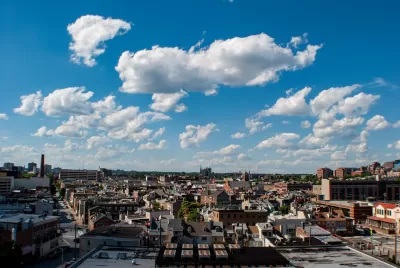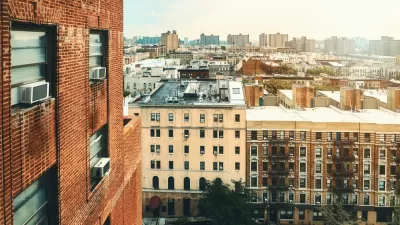Rising property values come with positive community development, but this shift can make neighborhoods inaccessible to low-income renters and fixed-income homeowners.

It’s time for some straight talk about rising property values. Yes, they help amass equity for homeowners, provide opportunities for developers, and generate revenue for localities. But they also raise rents, pushing out low-income renters; keep the unhoused, unhoused; and push fixed-income homeowners into fiscal precariousness. If community development is about the entire human community, and not just real estate, we must grapple with this tension. Higher property values and equitable development are not an easy marriage.
Parks, new housing, calm traffic, quality schools, the presence of grocers and other businesses, increased street lighting, a sense of community safety, blight reduction, and neighborhood cohesion all push property values higher. So does almost every aspect of positive community development. Remedying the racial imbalance in wealth creation through homeownership relies, to a great extent, on this property value appreciation. But if pushing values up for existing homeowners requires pushing out low-income homeowners and renters of limited means, and creates fewer affordable housing options for unhoused people, we have a quandary.
Baltimore distinguished itself in the post-World War II period as a city of homeowners. Almost two-thirds of its residents owned in the early 1950s, before government-subsidized and racially covenanted suburbs facilitated white flight, and the dynamics of increased global competition encouraged manufacturers to exit. Only 48 percent of the city’s residents own today, in a city that is about 62 percent African American.
Since that postwar peak, the value of homes in many neighborhoods has dropped.
Neighborhoods on both the west and east sides of the city that were redlined by the U.S. Home Owners Loan Corporation in a 1937 map are now, in the city’s 2017 Housing Market Typology map, marked as areas with sales values about 80 to 90 percent below average in Baltimore.
But on the east side, real estate developers transformed warehouses, flophouses, and wharves into luxury housing, thereby pushing up the property values of adjacent neighborhoods that had previously been classified as “stressed.”
It is in those ‘stressed’ neighborhoods that SHARE Baltimore’s network of community land trusts operates, and where we see firsthand the mixed blessing of high property values.
Low property values in the stressed neighborhoods—on both the east and west sides of Baltimore—discouraged property sales by homeowners for decades, facilitated homeowner-to-rental conversion, and contributed to a vacant housing stock in Baltimore that ranges from 16,000 to 47,000, depending on who’s counting. But, as property values on the east side now rise, vacant houses in stressed neighborhoods adjacent to prime neighborhoods are now becoming attractive to market-rate minded developers. As our CLTs seek to acquire these same vacant houses to rehab into permanently affordable homes, the competition with market-rate developers has pushed up our acquisition costs.
While most would assume that homeowners in these stressed neighborhoods on the east side would welcome the competition between developers and CLTs because it ultimately pushes up their own property values and increases home equity, it is not so simple.
Please see the source article linked below to continue reading.
FULL STORY: The Dirty Little Secret—Rising Property Values Are Incompatible with Affordability

Trump Administration Could Effectively End Housing Voucher Program
Federal officials are eyeing major cuts to the Section 8 program that helps millions of low-income households pay rent.

Planetizen Federal Action Tracker
A weekly monitor of how Trump’s orders and actions are impacting planners and planning in America.

Ken Jennings Launches Transit Web Series
The Jeopardy champ wants you to ride public transit.

Washington Legislature Passes Rent Increase Cap
A bill that caps rent increases at 7 percent plus inflation is headed to the governor’s desk.

From Planning to Action: How LA County Is Rethinking Climate Resilience
Chief Sustainability Officer Rita Kampalath outlines the County’s shift from planning to implementation in its climate resilience efforts, emphasizing cross-departmental coordination, updated recovery strategies, and the need for flexible funding.

New Mexico Aging Department Commits to Helping Seniors Age ‘In Place’ and ‘Autonomously’ in New Draft Plan
As New Mexico’s population of seniors continues to grow, the state’s aging department is proposing expanded initiatives to help seniors maintain their autonomy while also supporting family caregivers.
Urban Design for Planners 1: Software Tools
This six-course series explores essential urban design concepts using open source software and equips planners with the tools they need to participate fully in the urban design process.
Planning for Universal Design
Learn the tools for implementing Universal Design in planning regulations.
Heyer Gruel & Associates PA
Ada County Highway District
Institute for Housing and Urban Development Studies (IHS)
City of Grandview
Harvard GSD Executive Education
Toledo-Lucas County Plan Commissions
Salt Lake City
NYU Wagner Graduate School of Public Service





























